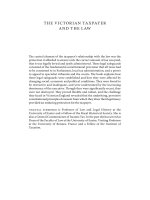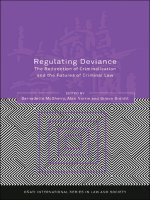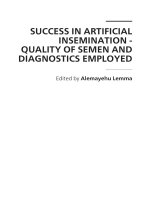Principles of Addictions and the Law ppt
Bạn đang xem bản rút gọn của tài liệu. Xem và tải ngay bản đầy đủ của tài liệu tại đây (1.58 MB, 373 trang )
Principles of Addictions and the Law
Applications in Forensic, Mental Health, and Medical Practice
This page intentionally left blank
Principles of Addictions
and the Law
Applications in Forensic, Mental Health, and
Medical Practice
Edited by
Norman S. Miller
AMSTERDAM • BOSTON • HEIDELBERG • LONDON
NEW YORK • OXFORD • PARIS • SAN DIEGO
SAN FRANCISCO • SINGAPORE • SYDNEY • TOKYO
Academic Press is an imprint of Elsevier
Academic Press is an imprint of Elsevier
32 Jamestown Road, London NW1 7BY, UK
30 Corporate Drive, Suite 400, Burlington, MA 01803, USA
525 B Street, Suite 1900, San Diego, CA 92101-4495, USA
First edition 2010
Copyright © 2010 Elsevier Inc. All rights reserved
No part of this publication may be reproduced, stored in a retrieval system or transmitted in any
form or by any means electronic, mechanical, photocopying, recording or otherwise without the
prior written permission of the publisher. Permissions may be sought directly from Elsevier’s
Science & Technology Rights Department in Oxford, UK: phone ( ϩ 44) (0) 1865 843830; fax
( ϩ 44) (0) 1865 853333; email: . Alternatively, visit the Science and
Technology Books website at www.elsevierdirect.com / rights for further information
Notice
No responsibility is assumed by the publisher for any injury and/or damage to persons or property
as a matter of products liability, negligence or otherwise, or from any use or operation of any meth-
ods, products, instructions or ideas contained in the material herein. Because of rapid advances in
the medical sciences, in particular, independent verification of diagnoses and drug dosages should
be made
British Library Cataloguing-in-Publication Data
A catalogue record for this book is available from the British Library
Library of Congress Cataloging-in-Publication Data
A catalog record for this book is available from the Library of Congress
ISBN : 978-0-12-496736-6
For information on all Academic Press publications
visit our website at www.elsevierdirect.com
Typeset by Macmillan Publishing Solutions
www.macmillansolutions.com
Printed and bound in United States of America
10 11 12 13 10 9 8 7 6 5 4 3 2 1
v
Contributors xv
Preface xvii
1 . The Basic Legal Structure and Organization 1
Anna Baumgras
Introduction : Sources of Law 1
The Judicial Branch 2
Civil Law Versus Criminal Law 3
Criminal Law 4
Defenses to Crimes 4
Civil Law 6
Offenses Related to Addictions 7
Basic Constitutional Rights 9
The Bill of Rights 9
The Legislative Branch 11
Statutes Regulating Addictions 12
Conclusion 16
References 16
2 . Addictions and the Law 17
Norman S. Miller and Sara Spratt
Mens Rea and Capacity 18
Definition and Relevance to Addictions 18
Legal Precedent 19
Addictive Disease 19
Intoxication and Addiction 19
Legal Precedent 20
Criminal Law 20
Insanity Defense 20
Legal Precedent 20
Criminal Competence 21
Civil Competence 21
Alcohol and Drug Use and Addiction as Risk Factors in
Crime and Criminal Intent 21
Civil Law in Selected Populations 22
Child Abuse and Custody 22
Sexual Offenders 23
Malingering 23
Contents
Contents
vi
Corrections and Coerced Treatment 24
Goals of Treatment 24
Diversion 24
Prevalence of Alcohol and Drug Disorders during Incarceration 25
Prevalence of Suicide and Alcohol and Drug Disorders during
Incarceration 25
Legal Precedent 25
The Death Penalty and Addictions 26
Involuntary Hospitalization 26
Malpractice 26
Competence to Sign into an Institution 27
Informed Consent 27
Injury to a Third Party by Alcoholics and Drug Addicts 28
Adolescents and Juvenile Court and Addictions 29
Prevalence of Alcohol and Drug Use and Disorders in
Juvenile Populations 29
Legal Precedents 30
Forensic Pathology and Drug Testing 30
Forensic Pathology 30
Drug Testing 30
Medical Records 30
Rehabilitation Acts
31
Conclusion 31
References 32
3 . Physician Practice of Addictions in Medical Practice 37
Norman S. Miller
Introduction 37
Clinical Prevalence 38
Prevalence of Alcohol and Drug Dependence in the General
Population 38
Prevalence of Multiple Drug Use and Dependence in
Treatment 38
Prevalence in the Medical Population 39
Prevalence in Family and Workplace Populations 39
Clinical Diagnosis 39
Risk Assessment by Physicians 40
Physical Examination and Laboratory Testing 40
Clinical Course and Pathophysiology 41
Clinical Comorbidity 41
Treatment of Medical Disorders Associated with Alcohol and
Drug Use and Addiction 41
Physician Intervention 41
Requirements of Physicians for Diagnosing and Treating
Addictive Disease 42
Abstinence-Based Method 43
Improving Treatment for Alcoholism 44
Contents
vii
Why Physicians are Unprepared to Treat Drug- and Alcohol-
Related Disorders 45
Recommendations for Improving Education Training 46
Research Studies on Medical Education in the Area of
Addictive Medicine 47
Conclusion 49
References 49
4 . Medical Licensure and Credentialing 55
Mark J. Greenwood and Maureen Beasley-Greenwood
Introduction 55
Peer Review 57
Immunity 57
Confidentiality 59
Physician Profile Databases 60
Medical Licensing Boards 64
Judicial Oversight 65
Federation of State Medical Boards 67
The Model Policy 67
Compulsory Reporting 67
Examination/Evaluation 68
Grounds for Action 68
Disciplinary Action against Licensees 68
Impaired Physicians 68
The Impaired Healthcare Professional 69
Identifying the Problem 69
Ethical Responsibility and Legal Risk 69
Confidentiality versus Disclosure 71
Physician Health Program (PHP) 72
R
eferences 72
5 . Privacy within the First Decade of the Twenty-First Century 75
Roy G. Beran
Introduction 75
Codes of Conduct for Privacy 76
Patient Access to Medical Records 76
Electronic Health Records 77
Update from the Privacy Commissioner 78
Practice Audits 79
Conclusion 79
References 80
6 . Bioethical Decisions, Substance Use and Addiction: The
Clinical Context 81
Sana Loue
Introduction 81
Substance Use, Addiction and Informed Consent 82
Contents
viii
Pregnancy , Substance Use and Addiction 83
The Effects of Substance Use on the Fetus 83
Legal Responses to Maternal Substance Use during Pregnancy 85
Ethical Issues for the Healthcare Provider 86
Liver Transplantation 87
Treating Pain 89
Conclusion 92
References 92
7 . Domestic Public Health Law 97
Lesley Stone and Susan C. Kim
Introduction 97
Controlled Substances 98
Harrison Narcotics Act of 1914 98
Federal Bureau of Narcotics and Henry Anslinger 99
Food and Drug Administration (FDA) 102
Food, Drug and Cosmetic Act of 1938 103
Prescription Drug User Fee Act of 1992 (PDUFA) 103
Federal Agency and Policy: Supply and Demand 105
Reducing the Supply of Illegal Drugs in the United States 105
The Other Side of the Coin: Reducing Demand for
Drugs in the United States 107
Conclusion 110
References 110
8 . International Law, Public Health and Addiction 113
Peter J. Hammer
What is International Law? 114
International Law in the Field of Addiction 115
Addiction: The Perspective of Drug Control 115
International Organizations and the Infrastructure of Drug Control 119
Addiction: The Perspective of Public Health 121
Why is International Law Relevant to Addiction Practitioners? 124
Physicians and Scientists 125
Lawyers and Judges 126
Social Workers, Community Activists, Policymakers and Sufferers of
Addiction 130
Addiction and Human Rights 130
International Advocacy and the Framework Convention on Tobacco
Control 131
References 132
9 . Medical Malpractice 135
Mark Cooney
Overview of Medical Malpractice Law 135
The Essential Elements 135
The Standard of Care: Duty and Breach 135
Contents
ix
Application to Addiction Cases 136
Standard of Care and Breach 136
Causation of Damages 143
Experts 146
Informed Consent 146
Defenses 149
Comparative Negligence 149
Assumption of Risk 152
Statute of Limitations 154
References 156
10 . Expert Witness in Civil and Criminal Testimony 159
Norman S. Miller
Expert Qualifications 159
Federal Rule of Evidence 702 159
Federal Rule of Evidence 703 160
Role of Experts 161
Duties of Experts 161
Mens Rea and Capacity 162
Expert Role in Criminal Cases 162
Medical Malpractice 163
Expert Role in Medical Malpractice Cases 163
Medical Experts 163
Admissibility of a Medical Expert 165
Damage Experts 165
Conclusion 166
References 166
11 . Forensic Considerations in Blood Alcohol Evaluation 167
Werner U. Spitz
Introduction 167
Alcoholism 167
References 174
12 . Pharmacological Drug Effects on Brain and Behavior 177
Richard A. Greer and Mark S. Gold
Introduction 177
Influence of Neurobiology and Neurotransmitters 178
Molecular Mechanisms and Neurobiological Consequences
of Drug and Alcohol Use 179
Performance-Enhancing Drugs 184
Conclusion 188
References 188
13 . Forensic Toxicology 193
Michele L. Merves, Bruce A. Goldberger
Introduction 193
Postmortem Forensic Toxicology 194
Contents
x
Human Performance Forensic Toxicology 195
Forensic Urine Drug Testing 195
Standard Operating Procedural Manual 196
Chain of Custody 196
Dual-Testing Philosophy 196
Sample Preparation 197
Liquid – Liquid Extraction 197
Solid – Phase Extraction 198
Detection Techniques 198
Immunoassay 198
Gas Chromatography 199
Liquid Chromatography 199
Mass Spectrometry 199
Method Validation 200
References 201
14 . Forensic Psychiatry, Substance Use and Mental Illness 203
Joel M. Silberberg and Adair Crosley
Introduction 203
Epidemiology 203
Basic Legal Concepts and Statutes 205
Affirmative Defense Statutes 211
Inherent Conflict Between Free Will, Public Safety and the Disease
Concept and Substance Addiction 213
Free Will 213
Disease Concept 214
The Conflict between Free Will, Public Safety and the
Disease Model 214
Criminal and Civil Competence for the Addicted 216
Competence to Stand Trial 217
Civil Competencies 218
Treatment Issues for this Population in Different Clinical Settings 219
Clinical Assessment in Forensic Settings 219
Treatment in Forensic Settings 219
Civil Commitment 220
Correctional Settings, Diversion and Coerced Treatment,
Community Re-entry and Reintegration 221
Conclusion 223
References 223
15 . Legal Rights of Fetuses and Young Children 229
Frank E. Vandervort
Introduction 229
Impact of Prenatal Drug Exposure on the Developing Fetus 230
Impact of Substance Abuse on Children 231
Need for and Access to Treatment 231
Rights of Fetuses Generally 232
Contents
xi
Rights of Fetuses: Civil Child Protective Proceedings 234
Response to Report 235
Courts ’ Responses to Child Protection Actions on
Behalf of Fetuses 236
Courts ’ Responses to Substance Exposed Neonates 237
Other Civil Remedies 238
Public Health Approaches 239
Criminal Charges 240
Search and Seizure and Consent 241
Charges that Can be Sustained 242
Charges that Cannot be Sustained 244
Access to Substance Abuse Treatment Records 245
Access to Records and HIPAA 247
Conclusion 248
References 249
16 . Criminal Populations and Substance Abuse 253
Roger H. Peters, John M. Ray and Janine Kremling
Introduction 253
Interventions for Substance Abuse in Correctional Facilities 254
Correctional Treatment Programs 254
Legal Standards for Substance Abuse Treatment in Correctional
Facilities 255
Judicial and Statutory Approaches to Substance Abuse 256
Civil Commitment for Substance Use Disorders 256
Drug Courts 257
State and Federal Drug Laws 259
Laws Regulating Drinking and Driving 261
Information Sharing Between the Justice and Treatment Systems 262
International Approaches to Criminal Populations and
Substance Abuse 264
Legal Foundations for Treatment Provided in Justice Settings 265
Points of Intervention for Offender Drug Treatment 266
Conclusion 269
References 270
17 . Legal Authority, Medical Basis and Public Policy for
Controlling and Scheduling Controlled Substances 277
Norman S. Miller
Overview of Controlling and Scheduling Drugs and
Other Substances 277
Legal Authority to Control Substances: Standards and Schedules 278
Federal Rules and Regulations for Controlled Substances 278
State Statutes and Regulations for Controlled Substances 279
Drug Enforcement Administration and Food and Drug
Administration 280
Contents
xii
Immediate Precursors 280
Temporary Scheduling to Avoid Imminent Hazards to Public Safety 280
Abuse Potential 281
Evaluation of Drugs and Other Substances 281
Factors Determinative of Control or Removal from Schedules 282
Legislative Intent for Potential for Abuse 283
Levels of Drug Control and Scheduling 284
Medical Basis for Potential of Abuse 287
FDA Role 287
Public Policy for Controlling and Scheduling Substances 288
References 290
18 . Use of Addictive Medications and Drugs in Athletics 293
Woodburne O. Levy and Kavita Kalidas
Introduction 293
Historical Perspective 296
Overview 299
Factors Influencing Athletes Use of Substances 299
Performance -Enhancing Drugs 300
Anabolic Steroids 300
Central Nervous System Stimulants 305
Erythropoietin and Blood Doping 313
Alcohol 314
References 315
19 . Class Action to Protect Against Discrimination
of Individuals with Alcohol and Drug Addictions 323
Norman S. Miller
Introduction 323
Class Action as a Thesis to Promote Change for Discriminated
Members 323
History of Mixed Success in Class Action Litigation for Addictions 324
Unfair and Lethal Discrimination against Classes of Addicted
Individuals Evident in Government Policy 325
Discriminatory Policies and Laws against Cigarette Smokers 325
Addiction 326
Addiction is a Disease Defined as a Medical Disorder and by
Legal Status 326
Addiction as a Medical Disease 327
Class Actions 327
Class Action Litigation is an Effective Strategy to Protect against
Discriminatory Policy and Laws 327
History of Tobacco Cases Demonstrate Powerful and Unethical
Forces against Traditional Litigation 328
Form a Discriminated Class of Harmed Individuals with Small
Claims to Make Class Tight and Class Action Superior 329
Public Support for a Class Consisting of Alcoholics and
Drug Addicts Suffering from a Disease 329
Contents
xiii
Class Defined 330
Numerosity and Commonality: Prevalent Disorders 331
Define Damages and Fraud Where Individual Issues do
not Predominate and Class Action is Superior to Traditional
Litigation for a Discriminated Class 332
Core Legal Theories and Causality 332
Specific Areas of Class Action Litigation in Medically-
Related Cases 333
Liability for Fraudulent Marketing of Controlled Substances:
Litigation against Purdue Pharma 334
Class Certification Upheld 334
Class Certification Denied 335
Medical Monitoring of a Class 335
Class Action is Superior to Other Methods 335
Superiority of Class Action Frequently Determines
Success of Litigation 336
Superiority can be a Single Forum 337
Predominance Requirement Depends on Individual Issues
for Causes in Addiction 338
Individual Interests in Controlling Individual Suits in Mass
Tort Litigation 339
Common Knowledge Theory 339
Conclusions
from Class Actions in Addiction 340
Legacies from Tobacco, Opiate Medications and Alcohol 340
The Road Less Traveled 341
References 341
Index 345
This page intentionally left blank
xv
Anna Baumgras (1), Midland, MI, USA
Maureen Beasley-Greenwood (4), Cherry Street Health Services, Grand Rapids, MI, USA
Roy G. Beran (5), South Western Clinical School, University of New South Wales:
School of Medicine, Griffith University; and Strategic Health Evaluators, Chatswood,
NSW, Australia
Mark Cooney (9), Thomas M. Cooley Law School, Lansing, MI, USA
Adair Crosley (14), Northwestern University, Chicago, IL, USA
Mark S. Gold (12), School of Law Department of Psychiatry, University of Florida
College of Medicine & McKnight Brain Institute, Depts of Psychiatry, Neuroscience,
Anesthesiology, Community Health & Family Medicine, Gainsville, FL, USA
Bruce A. Goldberger (13), Department of Pathology, Immunology and Laboratory
Medicine, University of Florida College of Medicine, Gainesville, FL, USA
Mark J. Greenwood (4), Aero Med Spectrum Health, Grand Rapids, MI, USA
Richard A. Greer (12), Division of Forensic Psychiatry, University of Florida, College
of Medicine, Department of Psychiatry, Gainsville, FL, USA
Peter J. Hammer (8), Wayne State University Law School, Detroit, MI, USA
Kavita Kalidas (18), Headache Fellow, Department of Neurology, University of South
Florida College of Medicine, FL, USA
Susan C. Kim (7), O’Neill Institute for National and Global Health Law, Georgetown
University, Washington, DC, USA
Janine Kremling (16), Department of Criminal Justice, California State University at
San Bernardino, CA, USA
Woodburne O. Levy (18), Department of Mental Health and Behavioral Sciences,
University of South Florida College of Medicine, James A Haley Veteran Affairs
Medical Center, Tampa, FL, USA
Sana Loue (6), Case Western Reserve University, School of Medicine, Department of
Epidemiology and Biostatistics, Cleveland, OH, USA
Michele L. Merves (13), Department of Pathology, Immunology and Laboratory
Medicine, University of Florida College of Medicine, Gainesville, FL, USA
Norman S. Miller (2, 3, 10, 17, 19), Department of Medicine, College of Human
Medicine, Michigan State University, East Lansing, MI, USA
Roger H. Peters (16), Department of Mental Health Law and Policy, Louis de la Parte,
Florida Mental Health Institute, University of South Florida, FL, USA
John M. Ray (16), Department of Psychology, University of South Florida, FL, USA
Joel M. Silberberg (14), Division of Psychiatry and Law, Feinberg School of Medicine,
Northwestern University, Chicago, IL, USA
Werner U. Spitz (11), Wayne State University School of Medicine, University of
Windsor, Ontario, Canada
Sara Spratt (2), Private Practice, Chicago, IL, USA
Lesley Stone (7), Georgetown University School of Foreign Service, Washington, DC,
USA
Frank E. Vandervort
(15), University of Michigan, Ann Arbor, MI, USA
Contributors
This page intentionally left blank
xvii
Drug and alcohol addictions and the law are historically well acquainted
in the American legal system. The pervasive presence of legal consequences
from alcohol and drug disorders is evidence in medical-legal populations. The
identification and treatment of addictive diseases are increasingly important in
forensic practice, particularly in cases pertaining to criminal conduct, malprac-
tice, employment, disability, child custody, and correctional psychiatry.
Courts make legal decisions that have direct bearing on the fate of those
with addictive disorders. The legislative branches of federal and state govern-
ments create significant and far-reaching laws that affect large numbers of
addicted individuals. The constitutional amendments, particularly the 14th
Amendment, provide due process and equal protection of the law for individu-
als with drug and alcohol addictions. Governmental administrative agencies
create policies, rules, codes, and regulations to execute legislative statutes that
govern the deterrence, treatment, prosecution, and diversion of offenders with
addictive diseases.
Alcohol and drug addiction occupy a paradoxical place within medicine
and the law. On the one hand, addiction is considered a disabling illness. As
early as 1925 the United States Supreme Court stated that addicts “ are diseased
and proper subjects for … treatment. ” On the other hand, addiction is consid-
ered willful misconduct. Although court decisions, the Rehabilitation Act of
1973, and the Americans with Disabilities Act of 1990 have provided protec-
tion for addiction treatment and rehabilitation, other court decisions and laws
have provided punishment for those with alcohol and drug addiction who com-
mit crimes.
Addiction to drugs and alcohol is a mental illness that can reduce the capac-
ity of the individual to resist the use of these substances and hence avoid the
resulting adverse consequences. The addictive drive can compel the individual
to relapse to the adverse effects of alcohol and drugs despite the initially intact
capacity to form intent in the legal sense in the abstinent state. Once the com-
pulsive use of drugs and alcohol is initiated, the capacity to form intent is fur-
ther compromised by the intoxicating effects of these substances acting directly
on the brain.
Addiction is a disease that is defined by a preoccupation with acquiring
alcohol and drugs, compulsively using them, and patterns of relapse to alcohol
and drugs. Preoccupation is demonstrated by a high priority for the use of alco-
hol and drugs in an individual’s life. Compulsivity is demonstrated by contin-
ued use despite recurring adverse consequences, including legal consequences.
Addicted individuals often relapse, returning to drug use despite adverse
consequences.
Preface
Preface
xviii
Legal decisions have acknowledged that addiction to drugs and alcohol is
not willful misconduct in a legal sense. Court cases have emphasized that being
a drug addict or an alcoholic is a status and not a crime.
Principles of Addictions and the Law is a book for mental health profes-
sionals, health practitioners, and legal professionals wanting to better under-
stand how the science of addiction may be relevant to the law, and how laws
and legal practices pertain to clients with addiction problems. Information in
this book will assist psychologists and physicians with understanding the proc-
ess and statutes that may apply to their client/patient, as well as information to
improve their knowledge in serving as an expert witness. Information in this
book will similarly assist legal professionals in understanding statutes and case
law pertaining to addiction.
The book begins with an overview of how addictions are treated within
the law, and moves on to privacy of medical records, bioethical decisions that
relate to substance abuse and addiction, drug testing – what it can and can’t
show, forensic toxicology, epidemiology, co-morbidity, the general biology
of addiction, and then the effects of substance abuse and addiction on special
populations.
As an introduction to some of the material covered later in the book, it may
be useful to know legal precedents relating to addiction and the law. In Robinson
v California, the U.S. Supreme Court ruled that the California law against being
a drug addict was unconstitutional. The Court said that the law could not make
“ status ” a crime, and the treatment and punishment represented different goals.
In Powell v State of Texas, the U.S. Supreme Court ruled that public drunkenness
was a crime, but that being an alcoholic (status) was not.
In Foucha v Louisiana, the U.S. Supreme Court ruled that Foucha was not
suffering from a mental illness, and that due process required that he could be
held only as long as he was both mentally ill and dangerous. He had committed
his crime while in a drug-induced psychosis. In the abstinent state, he was not
considered mentally ill, although he probably did suffer from a drug addiction.
Addiction is highly correlated with violence and criminal behavior.
According to the MacArthur study, substance abuse tripled the rate of violence
among individuals in the community who were not patients and increased the
rate of violence among discharged patients by up to five times. Patients dis-
charged from psychiatric hospitals who had symptoms of alcohol or drug use
were as violent as their neighbors who were not patients. In a study of self-
reported violence among 10,000 individuals within a community, alcohol and
drug abuse or dependence accounted for more than half of the incidences of
violence among those individuals who had psychiatric diagnoses. According to
another study, substance abuse is a much greater risk factor for violence than
is mental illness. Alcohol or drug dependence is the leading psychiatric diag-
noses in studies of completed suicides, and is a leading risk factor in those who
attempt and complete suicide.
Preface
xix
Alcohol and drug addiction are highly prevalent in criminal acts. All drugs,
including alcohol, are associated with crime. At least 35% of convicted
offenders were under the influence of alcohol at the time of their offense. An
additional significant proportion of offenders were using other drugs at the time
of their offense. More than 50% of murderers were using alcohol, drugs, or
both at the time of their crime. Alcohol, cocaine, amphetamine and derivatives,
phencyclidine hydrochloride, and heroin drugs are particularly linked to violent
behavior toward others.
In other studies, violence due to alcohol and drugs was attributed to crimes
to gain access to these substances and to resolve disputes over them, as well as
to the effects of these substances on the individual’s mind and behavior. Drugs
diminish control, impair insight and judgment, induce grandiosity and paranoia,
disinhibit, and provoke and stimulate uncontrollable behaviors. Alcohol intox-
ication was responsible for most violent crimes, including murders, assaults,
sexual assaults and family violence. Sixty-two percent of violence offenders
were drinking at the time of their crime. Among individuals with psychotic
disorders, those with substance-related co-morbidity and a history of violent
behavior are more likely to be hospitalized repeatedly and least likely to com-
ply with medications after discharge.
Alcohol and drug disorders are highly prevalent in incarcerated populations.
Lockups contain large numbers of individuals with alcohol and drug intoxica-
tion withdrawal. The suicide rate is higher in lockups than in jails or prisons.
Eighty-two percent of all jail inmates said they had used an illegal drug, and
25% stated they had received treatment for a mental or emotional disorder.
Sixty-one percent of the men and 70% of the women in jail had a lifetime prev-
alence of substance use disorder. Sixty-two percent of prison inmates reported
regular drug use of a drug at sometime in their lives. Half of all prison inmates
in 1991 had used cocaine in some form. More than 80% of the women in
prison had a lifetime prevalence of a substance use disorder. According to the
National Institute of Mental Health Epidemiologic Catchment Area program
study, 72% of prison inmates had a lifetime prevalence of substance abuse.
There is legal precedent in how to appropriately treat this population. The
8th Amendment prohibits cruel and unusual punishments. It applies to those
who are convicted of a crime, but not to the pretrial detainees. Convicted
prisoners, therefore have a constitutional right to medical care. In Estelle v
Gamble, the U.S. Supreme Court set the “ deliberate indifference ” to serious
medical need as the standard that constitutes “ unnecessary and wonton inflic-
tion of pain ” proscribed by the 8th Amendment.
In Ruiz v Estelle, prisoners brought forth a class action suit regarding con-
ditions of confinement. Six essential elements from the district court ruling pro-
vided guidelines for planning mental health services: systemic screening and
evaluation; treatment that was more than mere seclusion or close supervision;
participation by trained mental health professionals; accurate, complete and
Preface
xx
confidential records; safeguards against psychotropic medication prescribed in
dangerous amounts, without adequate supervision, or otherwise inappropriately
administered; and a suicide prevention program.
This gives a flavor of some of the issues relating to addiction and the law
discussed further in this book. Chapters here further discuss privacy issues of the
addicted patient, drug testing, forensic toxicology, epidemiology, co-morbidity,
the general biology of addiction, and the effects of substance abuse and addic-
tion on special populations. Written by experts in law and psychiatry, with case
law, clinical vignettes, and landmark cases to illustrate material, we believe this
book will be an important reference to those needing to better understand the
principles of addiction and the law.
Principles of Addictions and the Law: Applications in Forensic, Mental Health, and Medical Practice
Copyright © 2000 by Elsevier Inc. All rights of reproduction in any form reserved.
1
2010
The Basic Legal Structure and
Organization
Anna Baumgras
Midland, MI, USA
INTRODUCTION: SOURCES OF LAW
The United States legal system is structured to protect individual rights and pre-
vent overpowering government officials from violating those rights. The United
States Constitution is the supreme source of law. It establishes and controls the
legal system structure. All other laws are measured against, and must be con-
sistent with, the Constitution. The Constitution establishes two basic levels of
law: the state and the federal. At the federal level, the Constitution establishes
three sources of law: the Executive Branch, the Legislative Branch, and the
Judicial Branch (the Legislative Branch is governed by Article I; the Executive
Branch is governed by Article II; the Judicial Branch is governed by Article
III). All states have enacted a state constitution, which establishes the struc-
ture of the state government. Often the state constitution resembles the United
States Constitution, and therefore establishes a state executive branch, legisla-
tive branch and judicial branch. However, the state constitution details vary by
state. State law also establishes and regulates local law, including county, city,
township and village law.
Each branch of government serves a distinct purpose in governing the coun-
try and provides a “ check ” on another branch to keep the government balanced.
The Executive Branch is responsible for “ tak[ing] Care that the Laws be faith-
fully executed … ” (U.S. Const. art. II, § 3). In other words, the main purpose of
the Executive Branch is to execute the laws enacted by the Legislature. To exe-
cute these laws, the President appoints the heads of federal agencies. Agencies
are responsible for the day-to-day enforcement of laws and for supplementing
broad statutory language by promulgating rules and regulations. Examples of
agencies are the Environmental Protection Agency (EPA) and the Food and
Drug Administration (FDA). The Executive Branch also has the power to cre-
ate law by issuing Executive Orders and entering into treaties (U.S. Const. art.
II, § 2). The Legislative Branch is responsible for drafting and enacting stat-
utes (U.S. Const. art. I, § 8). The Judicial Branch is responsible for interpreting
Chapter 1
Principles of Addictions and the Law
2
laws, ensuring they are constitutional and applying them to the facts of a case
to facilitate an impartial outcome (U.S. Const. art. III, § 2). This chapter will
focus on the federal system, including the Judicial Branch, basic constitutional
rights and the Legislative Branch. It will also address how addictions interact
with the law.
THE JUDICIAL BRANCH
Article III, section 1 of the Constitution establishes the Judicial Branch by stat-
ing, “ The judicial Power of the United States shall be vested in one supreme
Court, and in such inferior Courts as the Congress may from time to time ordain
and establish ” ( Idem at § 1). Article III, section 2 provides the Judicial Branch
with authority over cases and controversies arising under the Constitution or the
laws of the United States ( Idem at § 2).
The United States has two basic court systems: the state and the federal. In
each of these systems there is a hierarchy of courts (see Figure 1.1). At the state
level, the lowest levels of courts are the Trial Courts, followed by the Appellate
Courts and finally the State Supreme Courts. At the federal level, the country is
divided into ninety-four districts and thirteen circuits. Each section represents
a court’s jurisdiction. The lowest levels of courts are the United States District
Courts, followed by the United States Courts of Appeals (Circuit Courts) and
finally the Supreme Court of the United States. Each lower level court is bound
by higher level court decisions within the same jurisdiction. The state courts are
also bound by the United States Supreme Court’s decisions. Additionally, each
court is bound by its prior decisions under the principle of stare decisis et non
quieta movere , which means “ to stand by things decided, and not to disturb set-
tled points ” ( Garner, 2004 ). These principles allow relative consistency in law.
The different levels of courts serve different functions. The trial court first
determines the facts involved in the case and establishes the record. The record
may consist of written memoranda of law (briefs) written by each party, oral
Supreme Court of the
United States
State Supreme
Court
Appellate
Court
Trial Court
United States District
Court
United States Court of
Appeals
FIGURE 1.1 Diagram of the Court System.
Chapter | 1 The Basic Legal Structure and Organization
3
arguments, testimony and exhibits. Then the trier of fact, either a judge or a
jury in the trial court, will apply the law to the established facts and make a
decision.
If either party is unhappy with the outcome, it may appeal the case. However,
only matters of law can be appealed. The appellate court reviews the trial court’s
decision for reversible error. The appellate court will neither hear new testimony
on the issue, nor review new evidence; it must base its decision on the record, the
written appellate briefs and the appellate oral arguments. Typically, the interme-
diate appellate court must hear a case because the parties have a right to appeal;
conversely, the Supreme Court (state or federal) can use discretion when deciding
whether to hear a case.
Currently there are over 2,000 special courts dedicated solely to presiding
over nonviolent drug and alcohol offenses (Office of National Drug Control
Policy). These courts, called “ drug courts, ” focus on the defendant’s treatment
and recovery, rather than his or her guilt. Offenders are placed in treatment pro-
grams that involve counseling, frequent drug testing and frequent court appear-
ances, rather than jail or prison. Participants in the drug court programs who
complete their treatment may have their charges dropped or their penalties
reduced (National Criminal Justice Reference Service). Research has shown
that participating in treatment rather than jail reduces the chance of future
criminal behavior (National Criminal Justice Reference Service).
CIVIL LAW VERSUS CRIMINAL LAW
There are two basic types of cases: civil and criminal. In a civil case, an
individual(s) (the plaintiff) files suit against another individual(s) (the defend-
ant). In a criminal case, the government, acting on behalf of the victim, files a
suit against the defendant. Each type of case has a different standard of proof
that the proponent of the case must satisfy to prevail. Generally, in a civil case
involving solely monetary interests, the plaintiff must prove his or her claim
by a “ preponderance of the evidence ” (more likely than not). If the civil case
involves a social policy interest, the plaintiff has a slightly higher stand-
ard of proof. He or she must prove his or her claim by “ clear and convincing
evidence. ”
Because the consequences for criminal cases are more severe, the burden
of proof is higher than in civil cases. The state must prove that the defendant
is guilty of every element of the alleged crime “ beyond a reasonable doubt. ”
Although there is no standard definition for beyond a “ reasonable doubt, ” the
Ohio Legislature has provided one definition:
“ Reasonable doubt ” is present when the jurors, after they have carefully considered and
compared all the evidence, cannot say they are firmly convinced of the truth of the charge.
It is a doubt based on reason and common sense. Reasonable doubt is not mere possible
doubt, because everything relating to human affairs or depending on moral evidence is
open to some possible or imaginary doubt. “ Proof beyond a reasonable doubt ” is proof of
Principles of Addictions and the Law
4
such character that an ordinary person would be willing to rely and act upon it in the most
important of the person’s own affairs.
(Ohio Rev. Code Ann. § 2901.05(E) (West 2008))
Criminal Law
Elements of Crimes
Most crimes consist of two elements: the actus reus , which is Latin for “ guilty
act ” ( Garner, 2004 ); and the mens rea , which is Latin for “ guilty mind ” ( Idem ).
In other words, to be convicted the defendant must have intended to commit a
crime and must have physically acted in furtherance of that crime. According
to the Model Penal Code (MPC) a failure to act may be considered an act. One
limitation of the act requirement is that the act must be a voluntary act. MPC
section 2.01(1) states: “ A person is not guilty of an offense unless his liability
is based on conduct that includes a voluntary act or the omission to perform an
act of which he is physically capable. ”
There are two forms of criminal intent ( mens rea ); general intent and spe-
cific intent. General intent is associated with criminal recklessness (conscious
disregard for a known risk) and criminal negligence (should have been aware
of a risk). Crimes that typically involve general intent include battery, rape, or
involuntary manslaughter. Specific intent is associated with purpose (conscious
object) and knowledge (aware that a result will occur). Crimes that typically
involve specific intent include assault, voluntary manslaughter and intent to kill.
There are two levels of punishment, depending on the severity of the crime.
The first is a misdemeanor, which is generally punishable by less than a year
in jail or a monetary fine. The second is a felony, which is generally punish-
able by at least one year in prison or possibly death. The defendant’s state of
mind at the time of the crime may also significantly impact on the level of pun-
ishment. For example, as discussed infra , diminished capacity may affect the
defendant’s ability to form the requisite intent.
Defenses to Crimes
Intoxication
Whether a defendant can claim intoxication as a defense to a crime often depends
on whether it was voluntary or involuntary intoxication. Voluntary intoxica-
tion occurs when the defendant intentionally consumes a substance known to
be intoxicating without any duress. The defendant does not have to intend to
become intoxicated. Voluntary intoxication may be a defense to specific intent
crimes if the defendant can prove it precluded him or her from forming the requi-
site intent; it is never a defense to general intent crimes. Involuntary intoxication
occurs when the defendant consumes an intoxicating substance under duress,
or when the defendant does not know the substance is intoxicating. Involuntary
intoxication may be a defense to both general intent and specific intent crimes.









